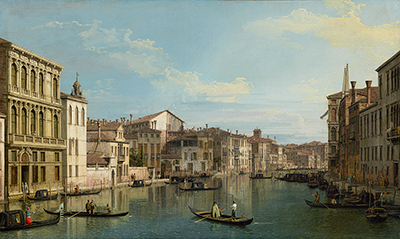The Grand Canal in Venice from palazzo Flangini to Campo San Marcuola by Canaletto. Giovanni Antonio Canal known by his name Canaletto was a great Italian painter born in Venice and he is known for his imaginary views (vedute) and the views of different cities such as the city of Venice, Rome and London.
He was given his nick name Canaletto meaning (little canal) from his father Bernardo Canal who also was a painter. Around 1738 he painted Grand Canal in Venice from Palazzo Flangini to Campo San Marcuola in J Paul museum Los Angeles, California. The art is painted using oil on canvas medium and has the following dimensions: 47cm by 78 cm. Through the eyes of Canaletto we are drawn to the entrance of the Grand Canal and we see people in their boats on the middle of the art. The details of the art shows how he took so much pleasure in drawing through the way he uses the bright colours to bring the real sense of the art with houses lining the bank. Together with his brother, Christoforo, they learnt about painting through apprenticeship from their father. He worked with both his father and brother on painting scenes from the theatre. They travelled to Rome in 1718, and here he was inspired by Giovanni Paolo Pannini and he started painting about the way of life in the city and the people in it.
In 1719 after his return from Rome he closely worked with Luca Carlevarijs a known painter of the urban views improving his skill tremendously and he produced one his first known work Architectural Caoriccio in 1723. Working through his agent swiny he was able to sell his work to Englishmen, who were not only on tour but also wanted to experience their visit. Later he worked with his agent Joseph smith, who was both a collector and a businessman. He trained his nephew Bernado Bellotto who acted as his assistance and they travelled together to Dolo and Padua where they got much inspiration for their future pieces. He inspired his work greatly that it was hard to distinguish their arts. His nephew used this to make a name for himself that he even signed his uncle's name in some of his arts. This caused a lot of challenges to his work as some critics called him an imposter.
It was perhaps rare at this time for an established Italian artist to move to the UK for an extended period in order to spread his architectural and artistic knowledge but the move taken by Canaletto helped him to expand his career as well as leaving behind an important legacy within his adopted country. Although he returned to Italy to continue his work there, he influenced British landscape art considerably and was particularly effective in raising the standards of local etchings, with many astounded by the quality of work that he dispersed around the UK whilst living there. The overall impact of his career would spread across Europe eventually, and helped to encourage new ideas within France and the UK particularly, ultimately leading to the French Impressionists and the earlier Romanticists, such as Turner, Constable and Monet.
He continued painting in Venice and died in 1768. Some of his other great work include:
- Campo San Giacomo di Rialto, Venice in 1697-1768
- The Piazzetta towards San Giorgio Maggiore in 1724
- Scala dei Giganti in 1765
- Veduta ideate with Roman ruins in 1720-21
- The Rialto bridge from the north in 1726-27
- The clock tower in the piazza san marco, Venice in 1730




